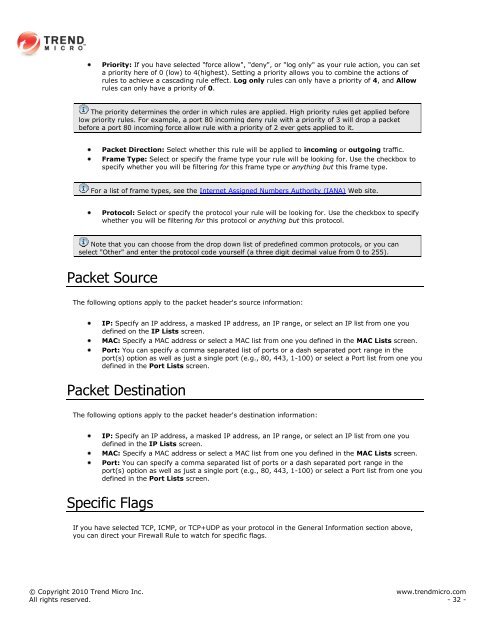Intrusion Defense Firewall 1.2 User's Guide - Trend Micro? Online ...
Intrusion Defense Firewall 1.2 User's Guide - Trend Micro? Online ...
Intrusion Defense Firewall 1.2 User's Guide - Trend Micro? Online ...
Create successful ePaper yourself
Turn your PDF publications into a flip-book with our unique Google optimized e-Paper software.
Priority: If you have selected "force allow", "deny", or "log only" as your rule action, you can set<br />
a priority here of 0 (low) to 4(highest). Setting a priority allows you to combine the actions of<br />
rules to achieve a cascading rule effect. Log only rules can only have a priority of 4, and Allow<br />
rules can only have a priority of 0.<br />
The priority determines the order in which rules are applied. High priority rules get applied before<br />
low priority rules. For example, a port 80 incoming deny rule with a priority of 3 will drop a packet<br />
before a port 80 incoming force allow rule with a priority of 2 ever gets applied to it.<br />
Packet Direction: Select whether this rule will be applied to incoming or outgoing traffic.<br />
Frame Type: Select or specify the frame type your rule will be looking for. Use the checkbox to<br />
specify whether you will be filtering for this frame type or anything but this frame type.<br />
For a list of frame types, see the Internet Assigned Numbers Authority (IANA) Web site.<br />
Protocol: Select or specify the protocol your rule will be looking for. Use the checkbox to specify<br />
whether you will be filtering for this protocol or anything but this protocol.<br />
Note that you can choose from the drop down list of predefined common protocols, or you can<br />
select "Other" and enter the protocol code yourself (a three digit decimal value from 0 to 255).<br />
Packet Source<br />
The following options apply to the packet header's source information:<br />
IP: Specify an IP address, a masked IP address, an IP range, or select an IP list from one you<br />
defined on the IP Lists screen.<br />
MAC: Specify a MAC address or select a MAC list from one you defined in the MAC Lists screen.<br />
Port: You can specify a comma separated list of ports or a dash separated port range in the<br />
port(s) option as well as just a single port (e.g., 80, 443, 1-100) or select a Port list from one you<br />
defined in the Port Lists screen.<br />
Packet Destination<br />
The following options apply to the packet header's destination information:<br />
IP: Specify an IP address, a masked IP address, an IP range, or select an IP list from one you<br />
defined in the IP Lists screen.<br />
MAC: Specify a MAC address or select a MAC list from one you defined in the MAC Lists screen.<br />
Port: You can specify a comma separated list of ports or a dash separated port range in the<br />
port(s) option as well as just a single port (e.g., 80, 443, 1-100) or select a Port list from one you<br />
defined in the Port Lists screen.<br />
Specific Flags<br />
If you have selected TCP, ICMP, or TCP+UDP as your protocol in the General Information section above,<br />
you can direct your <strong>Firewall</strong> Rule to watch for specific flags.<br />
© Copyright 2010 <strong>Trend</strong> <strong>Micro</strong> Inc. www.trendmicro.com<br />
All rights reserved. - 32 -
















